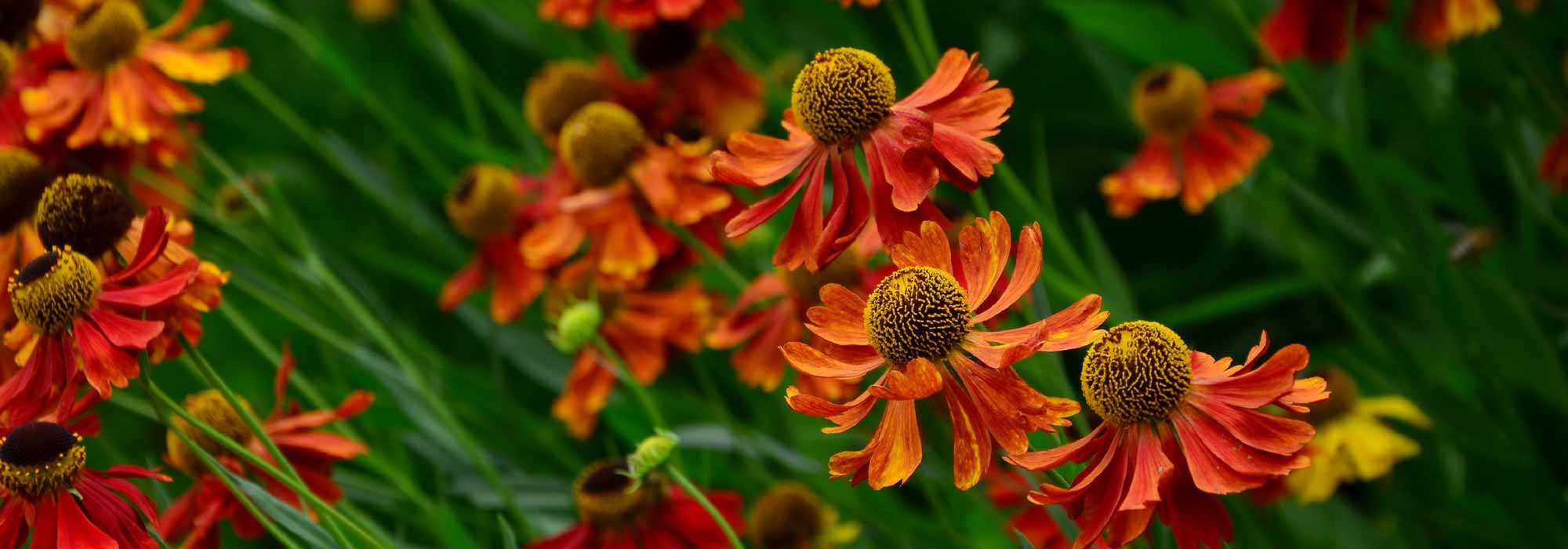
Helenium, Helen's flower: planting, cultivation, maintenance
Contents
Helenium in a nutshell
- Heliopsis, radiant and sun-loving, offers a long, vibrant flowering period in summer and autumn
- Its original flowers, resembling yellow, orange, red, and copper daisies, bloom continuously from summer to autumn
- Very easy to grow, it thrives in sunny locations and fertile, consistently moist soil
- It is a robust, hardy plant that is never diseased
- Along with Aster, it is THE essential perennial in autumn for cottage gardens, English mixed borders, and cut flower arrangements
A word from our expert
With its unconventional generous flowering reminiscent of a daisy, Helenium is a summer and autumn perennial with large flowers that is essential in all country or slightly wild gardens.
Featuring capitula with a particularly developed and rounded centre, the copper-red ‘Moerheim Beauty’, ‘Ruby Tuesday’, the pink ‘Tie Dye’, the canary yellow autumnal Helenium, Helenium puberulum, and Helenium bigelovii or “Bigelow’s Helenium”, all warm the garden with their symphony of vibrant hues, sometimes until autumn. There is a Helenium for every gardener!
With its strong presence, it sets the garden ablaze and creates scenes that are wild and full of colour! Its sunny flowers are great classics of mixed borders and sunny beds, bringing exuberance and whimsy.
It is a docile and hardy perennial, easy to grow in all gardens, in the sun, in cool and well-drained soil. Easy to combine, very versatile, it forms in just a few years beautiful clumps with exceptional floribundity in warm shades welcome at the end of summer and the beginning of autumn.
Discover in our Helenium collection the variety that your garden and bouquets are missing!
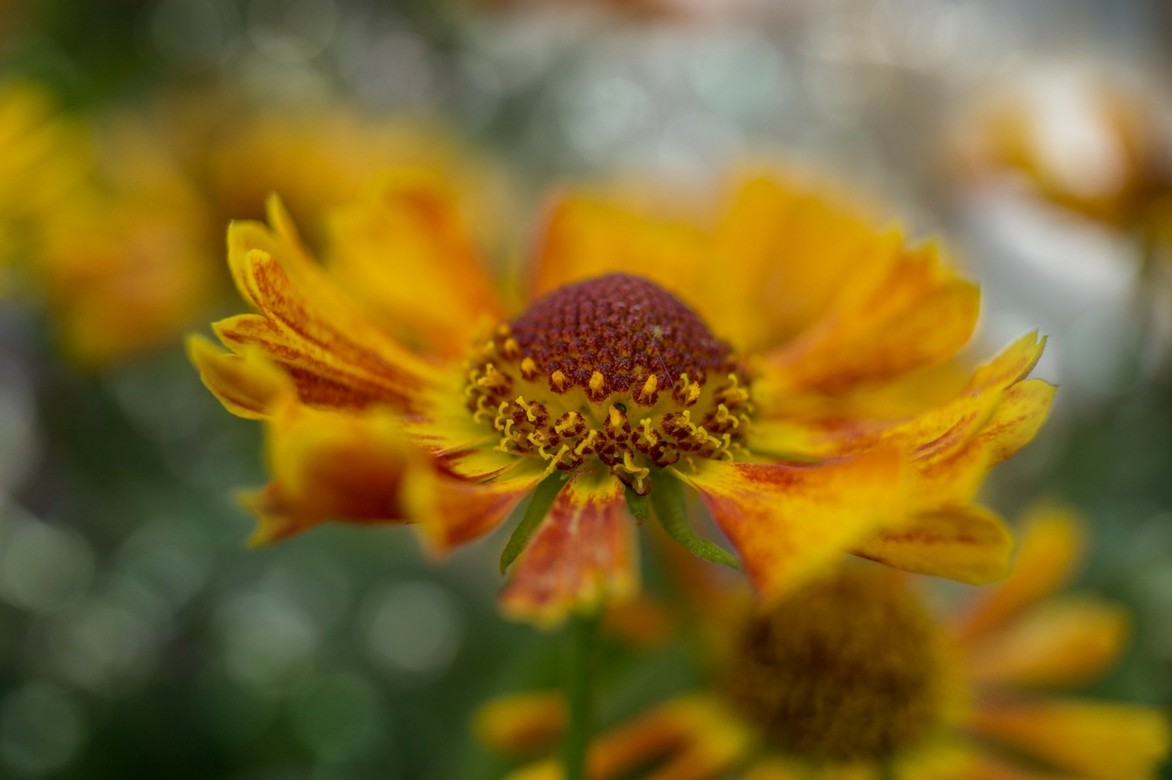
Description and Botany
Botanical data
- Latin name Helenium
- Family Asteraceae
- Common name Helenium, autumn daisy
- Flowering from June to autumn
- Height 0.60 to 1.50 m
- Exposure Sun
- Soil type All, well-drained
- Hardiness -15°C to -20°C depending on varieties
The Helenium, also known as the “autumn daisy“, is a perennial from the Asteraceae family, like its relatives the daisy and the aster. It is native to the wet meadows, marshes, and edges of swamps in North America.
The genus Helenium comprises around 40 species of perennial, annual, or biennial Heleniums. They have given rise to over 70 interesting hybrids and cultivars that vary in shape, height, and colour, such as ‘Moerheim Beauty’, the most popular of all Heleniums, and ‘Ruby Tuesday’.
Most hybrids are derived from Helenium autumnale. The Helenium hoopesii, Helenium puberulum, and Helenium bigelovii, or “Bigelow’s Helenium”, are also commonly found in our gardens.
This perennial has a upright tufted habit, fairly compact and somewhat untidy, easily reaching 1.50 m in height and 50 cm in width for the most imposing varieties.
Although it has a rapid growth rate, the Helenium requires about two years to establish well, then it grows over the years to form dense and highly floriferous clumps, which can even become invasive. Once well established, it can live for many years.
From a basal tuft of leaves gathered in a rosette, large slender yet robust stems emerge in spring, more or less branched at their upper part. With exceptional sturdiness, they are resistant to wind and generally do not require staking.
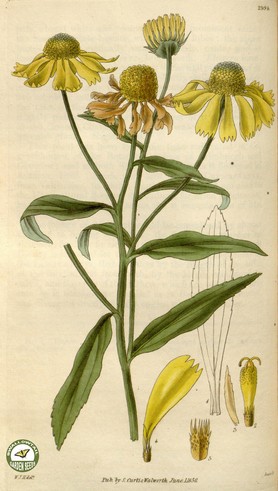
Helenium autumnale – botanical illustration
The Helenium exhibits a vigorous foliage whose main interest lies in its abundance. Deciduous, the leaves resemble those of daisies and Echinaceas. The straight stems are punctuated with narrow leaves 10 to 30 cm long, lanceolate in shape, and slightly dentate. Smaller towards the top of the stems, they are arranged alternately. They can sometimes be quite thick and vary from bright green to dark green or bluish.
Conquering and radiant, the flowers of the Helenium, a close relative of the sunflower, are undeniably solar in beauty. The warm tones of this flowering herald the fires of autumn.
There are early Heleniums that bloom from May to July and late Heleniums or “autumn Heleniums” whose flowering extends from August to the brink of winter. From June to November, depending on the varieties, the stems bear inflorescences in a large durable head 2 to 10 cm in diameter reminiscent of the shape of daisies, Rudbeckias, or Echinaceas.
All summer long and until the frosts, a myriad of flowers blooms tirelessly, sometimes gathered in corymbs of 3 to 8 at the tips of the stems.
They consist of a well-rounded hemispherical cone coloured in chocolate brown, old gold, or amber, which can sometimes be very prominent, forming a small rounded cushion gradually dotted with yellow stamens. The heart of this pompon is surrounded by a collar of fine petals or ligules, sometimes very rolled, arranged in one or two rows (Helenium ‘Double Trouble’). Closely packed, they are slightly notched into 3 to 5 teeth at their tips and can spread almost horizontally or, conversely, bend significantly downwards at maturity, as seen in Helenium hoopesii.
These well-opened corollas display vibrant autumn colours, taking on all the warm shades, from the brick red of Helenium Moerheim Beauty, to the ruby red of Helenium ‘Ruby Tuesday’, to the bright coppery orange of Helenium ‘Short’n ‘Sassy’, or the sunny yellow of Helenium ‘Kugelsonne’. Some multicoloured or bicoloured florets are streaked with yellow, red, orange, and copper.
This remarkably generous flowering, lasting 6 to 10 weeks, colourful and melliferous, spans the entire summer: the flowers renew themselves continuously until autumn, attracting bees and butterflies to the beds.
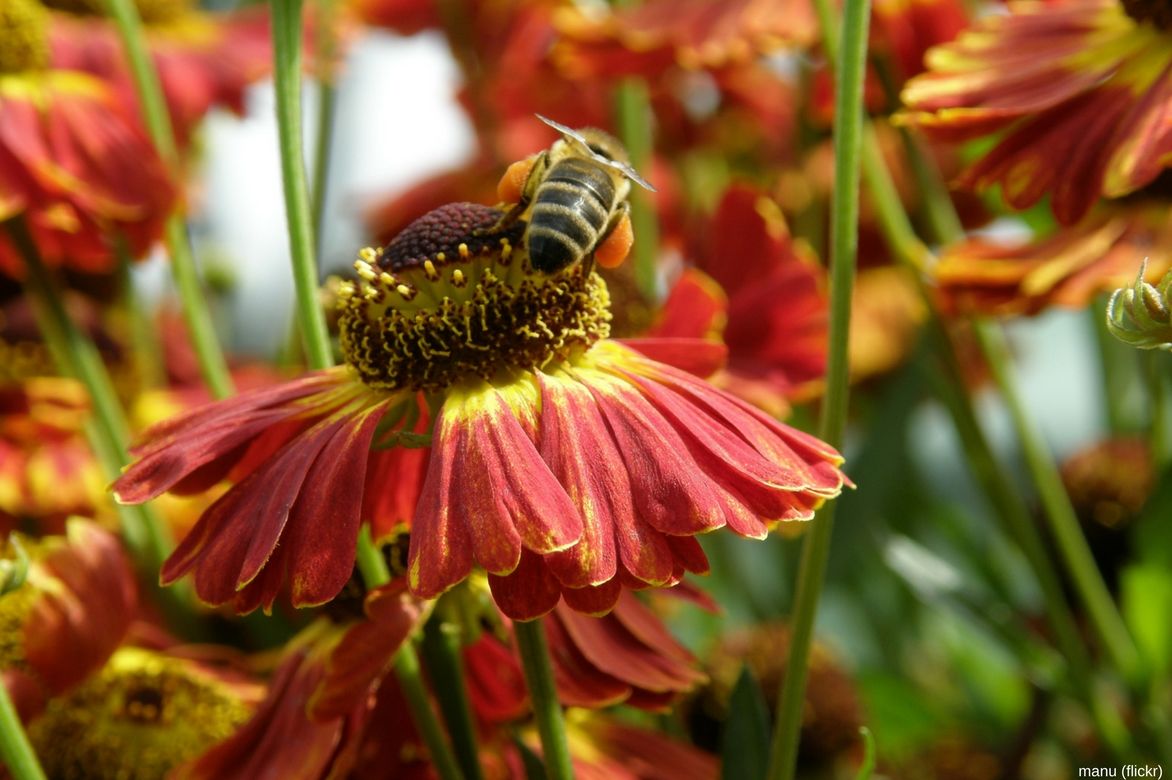
The flowers of Heleniums are melliferous.
Fresh flowers, long-lasting in a vase, make for beautiful vibrant summer bouquets.
Very hardy, well below -15°C, the Helenium can be grown in all regions. Never sick, the Helenium is easy to cultivate in the sun, in any good garden soil that remains slightly moist, although it will be more exuberant in soil rich in organic matter. It is a robust plant that can withstand intense heat and drought occasionally.
It flowers in naturalistic beds, enlivens slopes, and delights English mixed borders. Some varieties are also suitable for container cultivation.

From left to right: Helenium autumnale ‘Mardis Gras’, Helenium ‘Zimbelstern’, Helenium ‘Baudirektor Linne’, Helenium ‘Double Trouble’, Helenium ‘Bandera’.
Read also
Growing Helenium in a potMain species and varieties
The complex and warm colours and heights (from 0.60 to 1.50 m) of Heleniums abound in a myriad of warm shade variations ranging from yellow to ruby red, including coppery orange, and many cultivars are now available such as ‘Moerheim Beauty’, the most popular of all heleniums, and ‘Ruby Thuesday’.
There are early heleniums that flower all summer and late ones or “autumn daisies” that begin to bloom in summer and flourish in autumn.
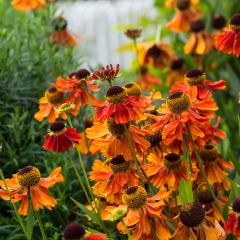
Helenium Moerheim Beauty
- Flowering time July to October
- Height at maturity 90 cm
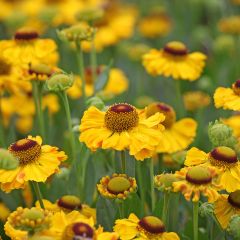
Helenium El Dorado
- Flowering time August to October
- Height at maturity 1 m
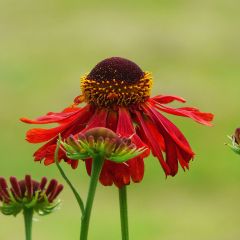
Helenium Ruby Tuesday
- Flowering time September to November
- Height at maturity 55 cm
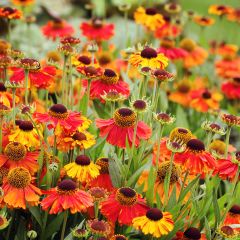
Helenium Sahins Early Flowerer
- Flowering time August to December
- Height at maturity 1 m
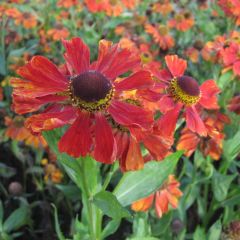
Helenium Baudirektor Linne
- Flowering time August to October
- Height at maturity 1,50 m
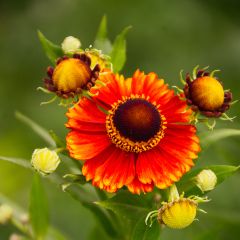
Helenium Dunkle Pracht
- Flowering time August to October
- Height at maturity 90 cm
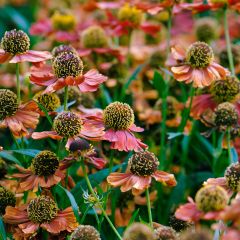
Helenium Rubinzwerg
- Flowering time August to November
- Height at maturity 80 cm
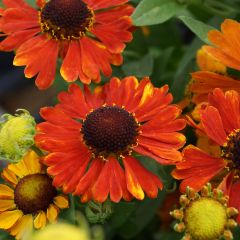
Helenium Mardi Gras
- Flowering time August to October
- Height at maturity 60 cm

Helenium Tijuana Brass
- Flowering time August to October
- Height at maturity 1,50 m
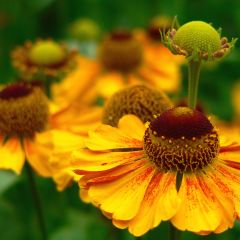
Helenium Zimbelstern
- Flowering time September to November
- Height at maturity 1,20 m
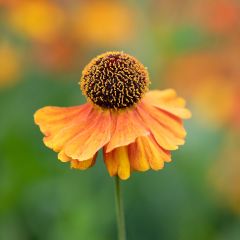
Helenium Waltraut
- Flowering time August to October
- Height at maturity 80 cm
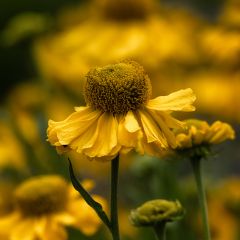
Helenium Pumilum Magnificum
- Flowering time July to September
- Height at maturity 80 cm
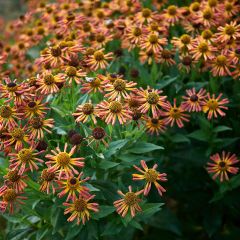
Helenium Loysder Wieck
- Flowering time August to October
- Height at maturity 90 cm
Discover other Helenium
View all →Available in 1 sizes
Available in 1 sizes
Available in 1 sizes
Available in 2 sizes
Available in 1 sizes
Available in 3 sizes
Available in 1 sizes
Available in 3 sizes
Available in 1 sizes
Available in 1 sizes
Planting
Where to Plant Helenium
Very easy to grow, with good hardiness (down to -15°C), Helenium thrives almost everywhere in France and adapts well even by the seaside.
Once well-rooted in a suitable location, it flourishes year after year, becoming increasingly floriferous and can even become invasive, potentially smothering its neighbours. It can self-seed spontaneously. It struggles a bit with the close presence of other plants, so choosing the right spot for planting is imperative: give it some space!
Select a sunny spot sheltered from the wind, which could bend the stems of the taller specimens.
This beautiful perennial grows in heavy, clayey, and marshy soils; it is sometimes used to naturally drain overly wet ground. While it accepts all types of soil that are not too dry, it will thrive in deep, fertile soil. The soil should be rich in organic matter to allow the plant to bloom well. In poor soil, it will manage but will never be lush.
It prefers a well-drained soil that remains cool during summer, especially in the first few years; it will tolerate occasional drought better over time. Winter flooding is fatal for it: it needs a filtering, well-drained soil.
Versatile, it fits into all settings and can be used in borders or beds. The tallest Heleniums (‘Kugelsonne’) will form imposing flowering bushes at the back of borders. Smaller Heleniums will add height to the edges. Some reasonably sized varieties are also suitable for pot cultivation.
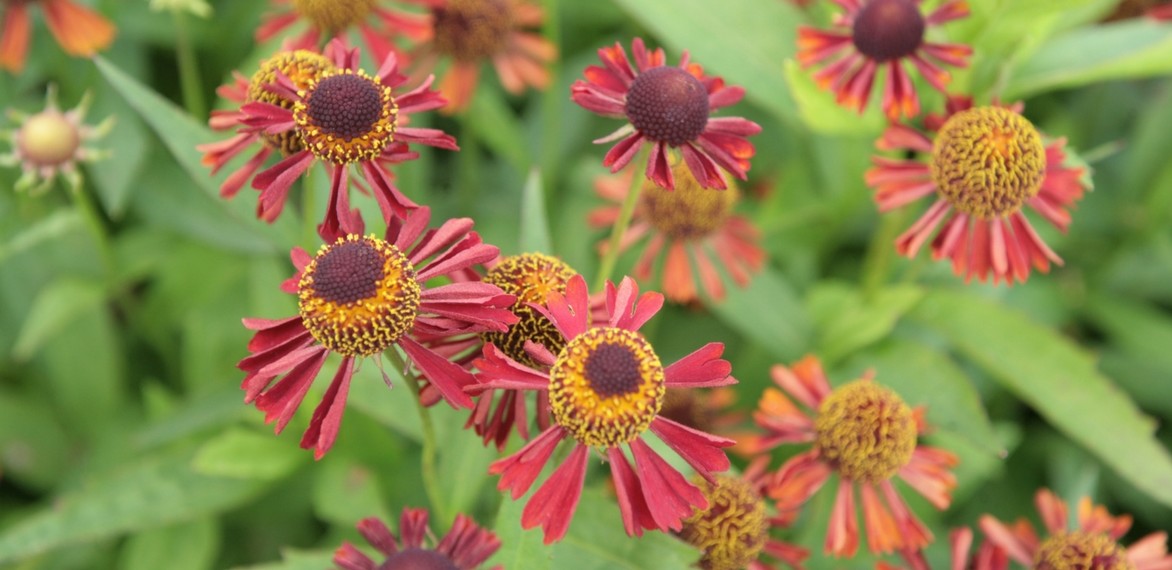
Flowers of Helenium ‘Ruby Tuesday’.
When to Plant Helenium
Helenium is ideally planted in spring in March or April in colder regions or in autumn in September-October elsewhere, avoiding periods of frost and drought.
How to Plant Heleniums
In the Ground
Maintain a distance of 30 to 40 cm between plants and plant in numbers: count 3-5 pots per m², given the strong growth of this perennial, this is sufficient to create a striking effect in a border.
Helenium is a heavy feeder; the soil must be well amended: make a good addition of well-decomposed compost.
- Prepare the soil well, removing weed roots and stones
- Plant it in a mixture of potting soil, with a good dose of well-decomposed compost
- Mulch in spring with pine bark to keep the soil cool during summer; this ensures prolonged flowering
- Water regularly after planting
- In spring, protect young shoots from snails and slugs
Even more than in the ground, Helenium will need plenty of water. Choose a variety with a compact growth habit.
- Plant it in a large container, in a mixture of potting soil and compost that is always moist
- Spread a good layer of drainage (gravel or clay balls) at the bottom of the pot for proper drainage
- Mulch and water very regularly, never allowing the substrate to dry out
- Fertilise regularly with organic fertiliser during the flowering period
Read also
Choosing HeleniumsCaring for Heleniums
Helenium is a low-maintenance perennial as long as it receives enough light and water during summer. Once well established, it requires little care provided the soil is well-draining, sufficiently nourishing, and cool in summer.
In the first springs and summers, provide it with generous watering. During dry spells, water daily but avoid flooding.
Maintaining heleniums is straightforward:
- In spring, before the growth starts for late-flowering varieties or in autumn after flowering, cut back the dry stems to 15 cm above the soil using shears.
- Take the opportunity to add one or two shovelfuls of compost at its base: remember, they thrive in fertile soils,
- Mulch in May to ensure the base remains sufficiently cool in summer.
- Support the tallest varieties if necessary.
- In summer, remove flowers as they fade to prolong flowering.
Every 3 to 4 years, in spring or autumn, divide the largest clumps if the plant shows signs of fatigue to rejuvenate it.
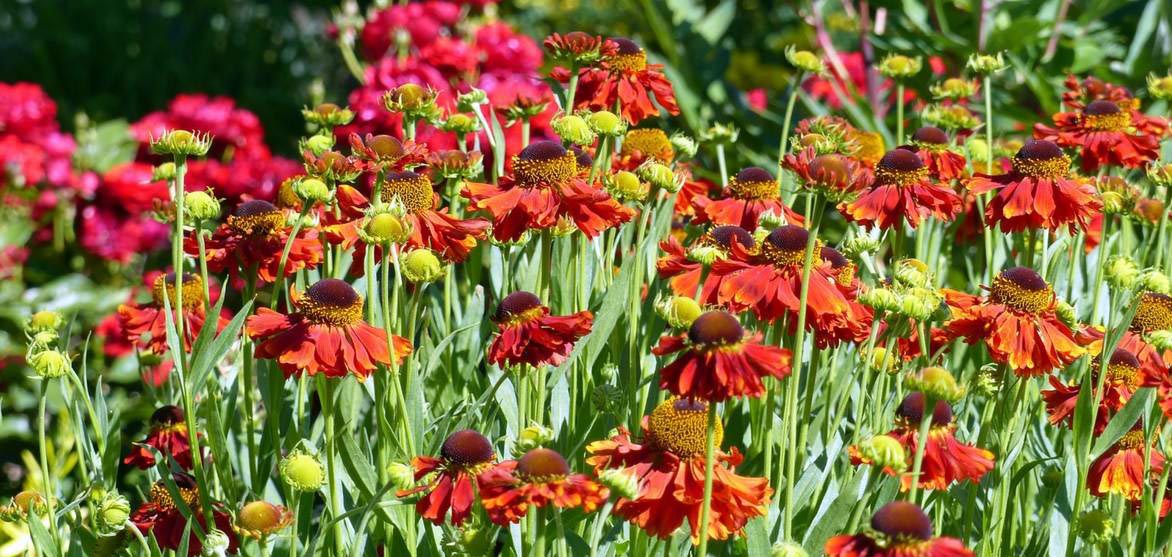
Beautiful clump of Helenium ‘Moerheim Beauty’.
Diseases and potential pests
Never sick, Helenium has only a few rare enemies: gastropods, at the start of the growing season. In spring, protect its young shoots from the appetite of slugs and snails. Discover all our tips in our sheet: “Slugs: 7 effective ways to fight naturally”
It can sometimes be susceptible to powdery mildew and foliar spots (rust), especially when planted too much in the shade, in a somewhat confined situation, or in soil that is too heavy and damp. To prevent and combat powdery mildew, follow our advice: “Powdery mildew or white disease: prevention and treatment”
Multiplication
To multiply Helenium, division remains the least tedious operation. Root cuttings are possible but quite delicate. Sowing is a method that allows for a large number of plants, but we do not recommend it for botanical species whose flower colour remains true.
Division
Dividing clumps should be done after 3 or 4 years, when the plant is well established. Divide late-flowering Heleniums in March and early-flowering Heleniums in October.
- Using a sharp spade, cut some clumps from the periphery, ensuring each has at least one bud and a root
- Take the opportunity to rejuvenate the plant by keeping only the outer clumps and discarding the central mass
- Replant these clumps immediately in the garden in well-tilled, fresh soil
How to sow Helenium?
Helenium is a perennial that is very easy to grow from seeds. Sowing can be done directly in the ground in autumn or in May, or in seed trays from January to March using well-ripened seeds collected in autumn or purchased seeds.
- Sow in a mixture of potting soil and river sand, covering them lightly
- Place the seed tray under a warm frame at 15-20°C
- Water regularly but do not saturate the substrate
- Expect germination in 2 to 3 weeks
- When the seedlings have two true leaves, transplant them into individual pots
- Plant them in the ground in autumn or the following spring when the seedlings have hardened off
- The plants will flower by the second year after sowing
→ Learn more about multiplying Heleniums in our tutorial sheet!
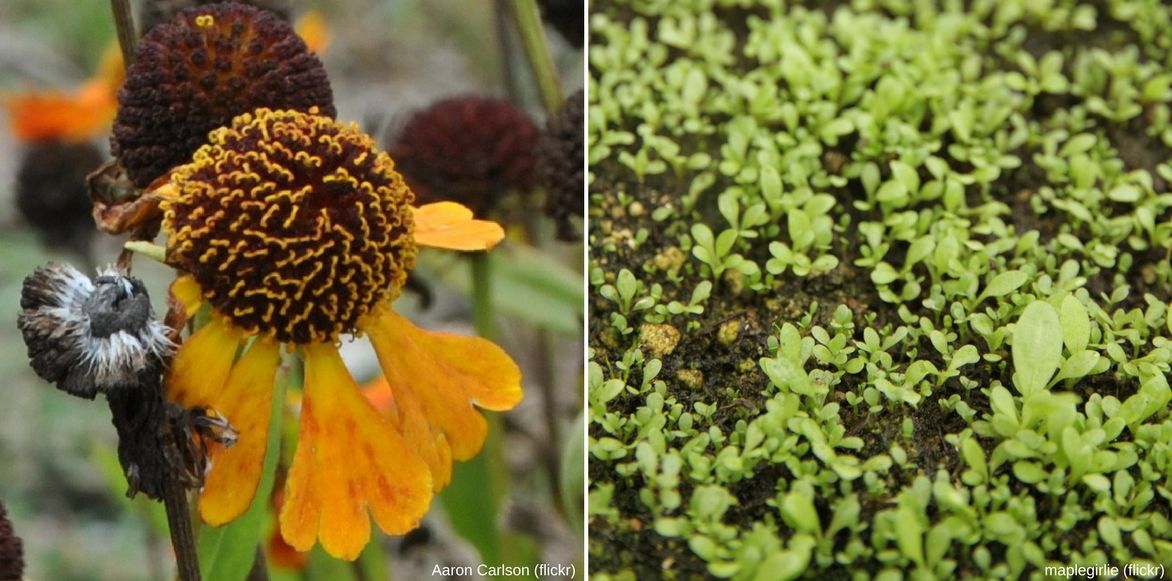
Associate Helenium with the garden
Helenium is particularly inspiring for creating a naturalistic garden, or a mixed border in the spirit of cottage gardens with other easy-going upright perennials. Its original, sunlit flowers splash colour in summer and autumn, creating beds and borders of fiery brightness.
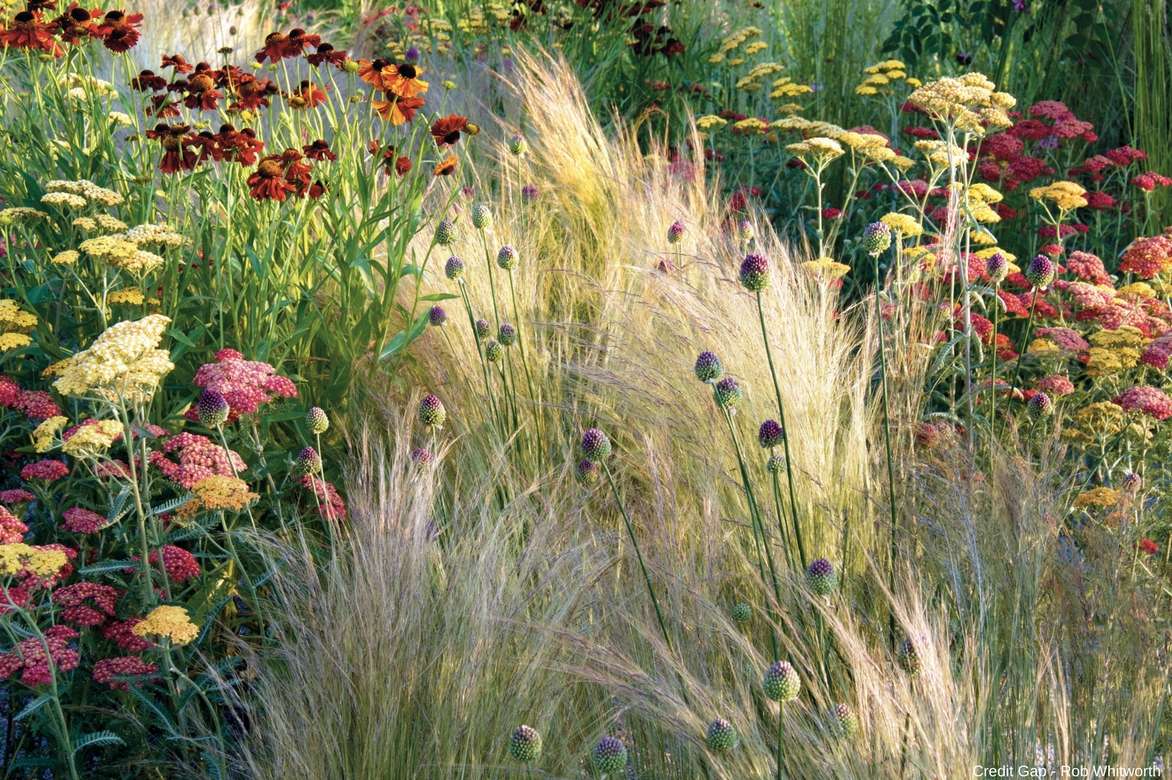
A stunning natural scene: Achillea ‘Terracotta’, Achillea ‘The Beacon’, Achillea ‘Paprika’, Helenium ‘Moerheim Beauty’, Stipa tenuifolia, Allium sphaerocephalon.
It is essential for creating wild-looking scenes, lush and vibrant at the heart of summer.
When planted in groups rather than alone, it adds substance to a border with its strong chromatic presence, either by providing contrast or in a gradient or monochrome version.
Its intense colours can easily be paired with the complementary colours (crimson/blue) of asters and sages for a joyful and exuberant spirit.
For a mix of explosive tones, it can be combined with Echinaceas, Oriental Poppies, Rudbeckias, Daisies, Achilleas, Agastaches, Helianthus, Coreopsis, Echinops, perennial chrysanthemums, or Phlox.
Its slightly unruly habit will provide, in a lush summer border, a contrast of form with plants that have more defined outlines, such as dahlias, kniphofias, cannas, and crocosmias. Lightly structured perennials like Gaura, Gypsophila, and grasses like Miscanthus will add softness and movement, contrasting with the somewhat stiff habit of Helenium.
At the edge of a border, modest-sized Heleniums will shine alongside Sages, Daylilies, and Heucheras, which will enhance its warm tones.
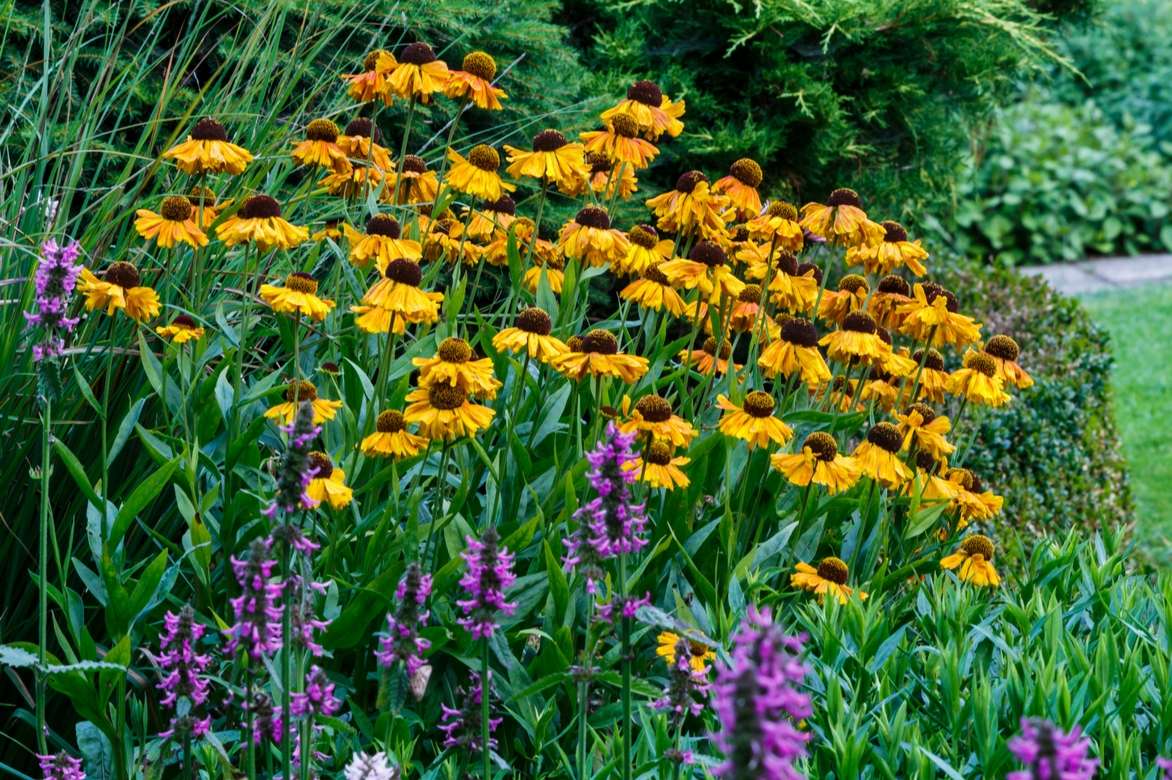
An association idea: Helenium ‘Windley’, Miscanthus sinensis ‘Gracillimus’, and Stachys officinalis.
The grey or blue foliage of Artemisias or Santolines, hostas, and grasses (Blue Fescues) will be perfect to calm the fire.
It can also be paired with a euonymus or a Japanese maple with sumptuous autumn foliage.
→ Discover more pairing ideas with Heleniums in our advice sheet.
Useful resources
- Discover the most beautiful heleniums, including some rare and exclusive ones in our Helenium collection
- Virgnie’s advice sheets: Heleniums, the most beautiful varieties, 6 ideas for pairing Heleniums
- Subscribe!
- Contents
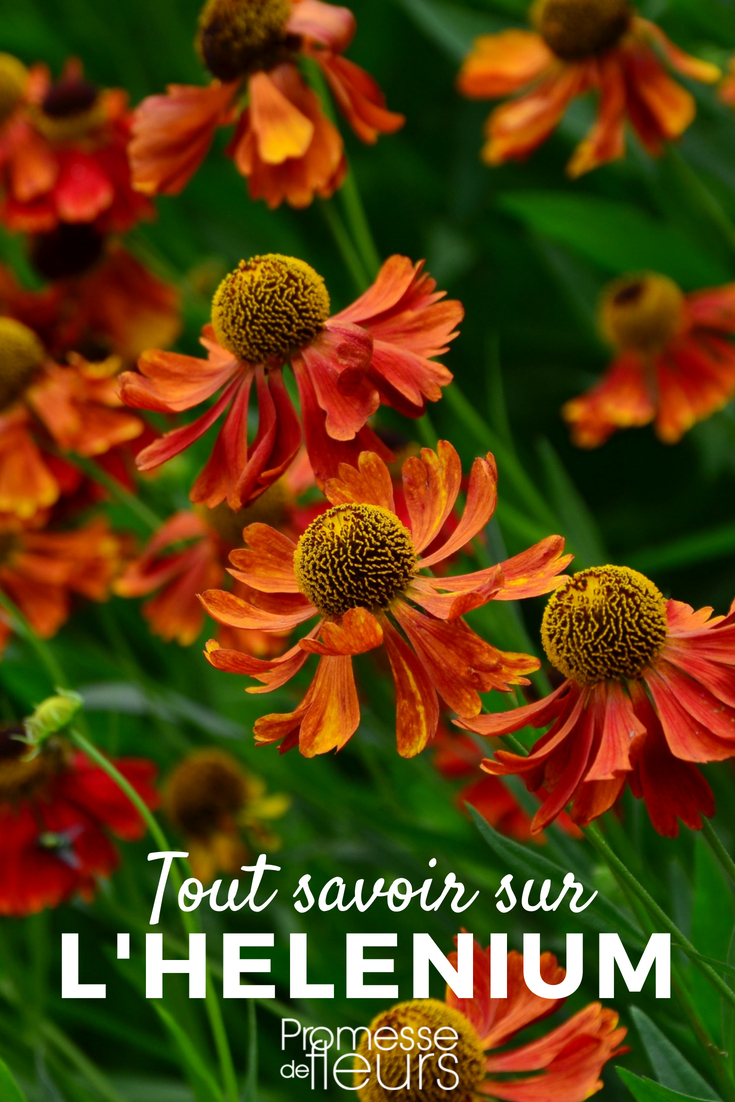































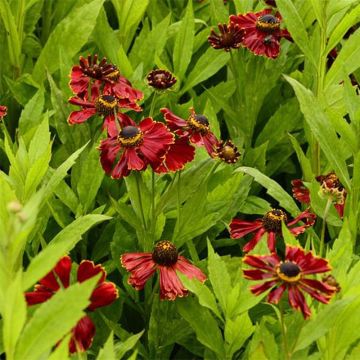
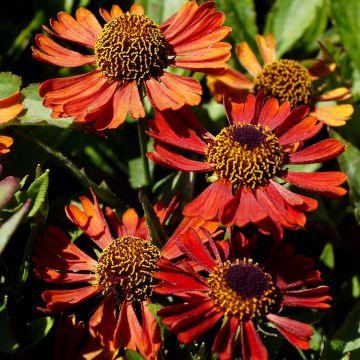
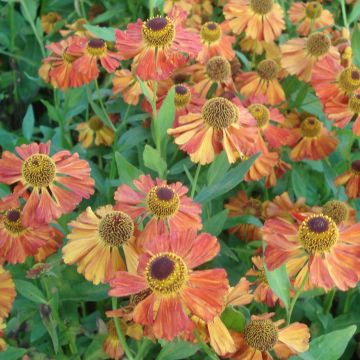
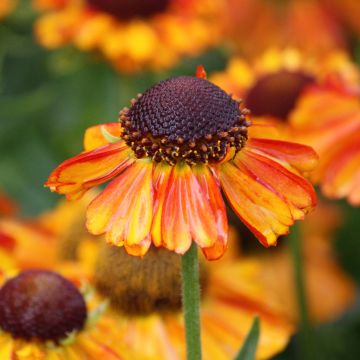
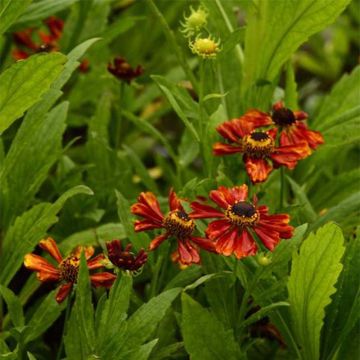
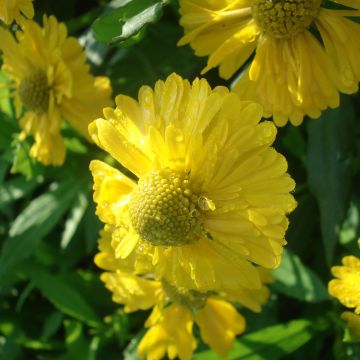
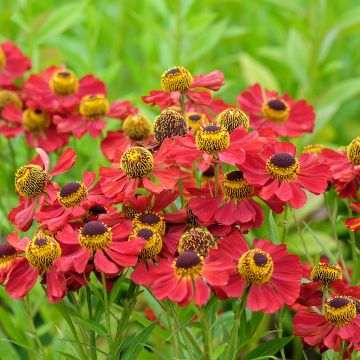

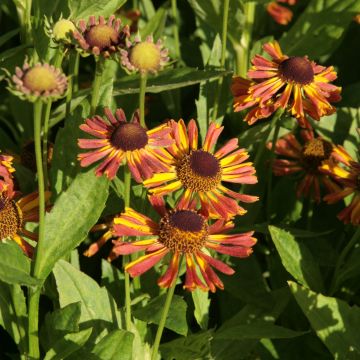
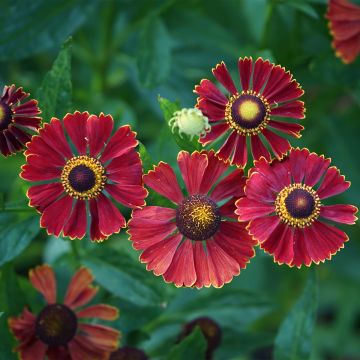
Comments